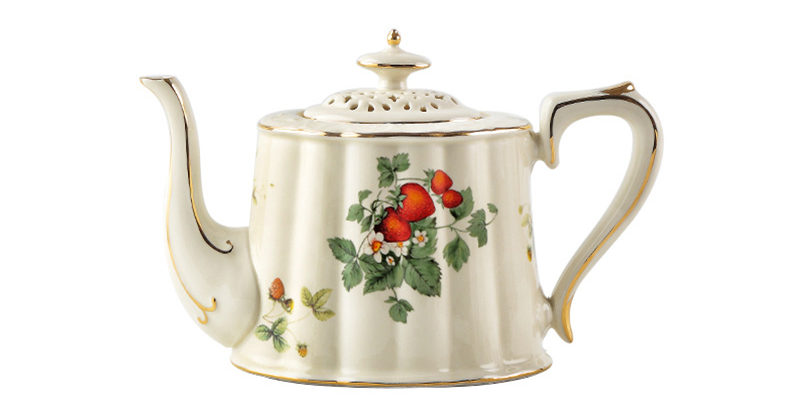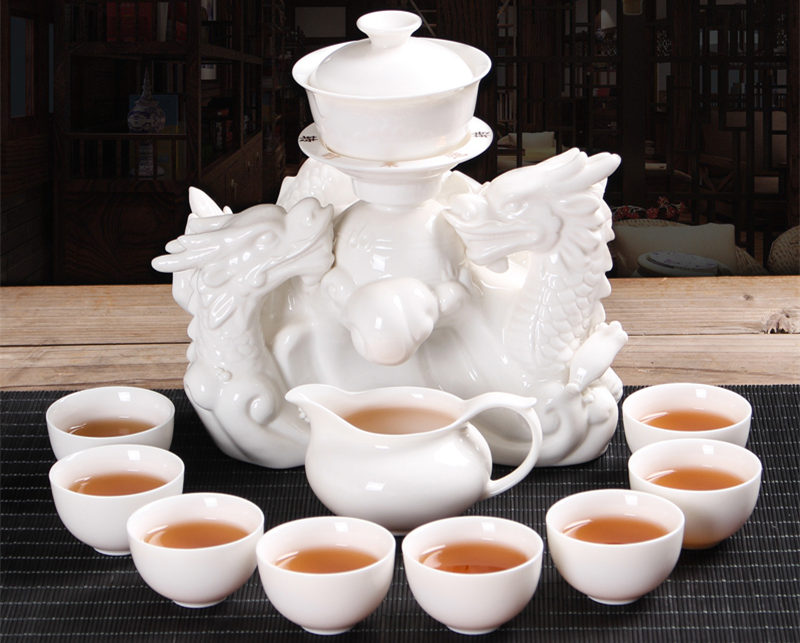Porcelain Vs Ceramic Tea Sets
Time of issue: 2024-03-22 15:50:11
Introduction:
When indulging in the ritual of tea drinking, the vessel from which you sip can significantly influence your overall experience. Two popular options, porcelain and ceramic tea sets, offer unique qualities that cater to different preferences and needs. In this article, we'll unravel the disparities between porcelain and ceramic tea sets, aiding you in making an informed choice to enhance your tea-drinking moments.
The History Of Tea:
According to PEETS. the history of tea began in 2737 B.C.E. when the Emperor Shen Nong, a skilled ruler and scientist, accidentally discovered tea. While boiling water in the garden, a leaf from an overhanging wild tea tree drifted into his pot. The Emperor enjoyed drinking the infused water so much that he was compelled to research the plant further. Legend has it that the Emperor discovered tea's medicinal properties during his research.
Whatever the legend, tracing tea's original roots proves difficult. It is probable that the tea plant originated in regions around southwest China, Tibet, and Northern India. Chinese traders may have traveled throughout these regions often and encountered people chewing tea leaves for medicinal purposes.
It was not until the Tang dynasty (618-907), often referred to as the classic age of tea, did consumption become widespread. A government-imposed tea tax further evidences the beverage's growing popularity, and it was at this time that tea was recognized as China's national drink.
During the Tang dynasty, a Buddhist monk, Lu Yu (733-804) composed the Ch'a Ching or Classic of Tea treatise. He described types of tea, its uses, as well as the preparation and benefits of drinking it. More importantly, he imbued the writings with a spiritual aesthetic that reflected Buddhist, Taoist, and Confucian religious thoughts of the time. These teachings were centered around a traditional tea ceremony, which served as a metaphor for expressing the harmony and simplicity that not only ordered, but also streamed throughout the entire universe.
Is Ceramic Good For Tea?
In the world of tea aficionados, the vessel from which you brew and serve your tea plays a crucial role in the overall experience. Ceramic, renowned for its durability and versatility, is a popular choice for tea enthusiasts seeking to elevate their tea-drinking rituals.
The Benefits of Ceramic for Brewing Tea:
Heat Retention: Ceramic teapots and tea cups excel in retaining heat, ensuring that your tea remains at the desired temperature for longer periods. This is particularly advantageous for teas that require steeping at specific temperatures to extract their optimal flavors and aromas.
Even Heat Distribution: Ceramic's ability to distribute heat evenly throughout the vessel promotes uniform steeping, allowing the tea leaves to release their flavors and essences harmoniously. This results in a well-balanced and flavorful brew, enhancing the overall tea-drinking experience.
Neutral Taste: Unlike certain materials that may impart unwanted flavors or odors to the tea, ceramic is inert and does not alter the taste or aroma of the brewed tea. This purity allows the natural flavors of the tea leaves to shine through, ensuring a clean and authentic tea-drinking experience.
Versatility: Ceramic teapots and tea cups come in a wide range of styles, shapes, and designs, catering to diverse preferences and aesthetics. Whether you prefer classic elegance, modern simplicity, or artisanal craftsmanship, there's a ceramic tea vessel to suit your taste and complement your decor.
Considerations When Using Ceramic for Tea:
Fragility: While ceramic is durable and resistant to heat, it may be more prone to breakage or chipping compared to materials like glass or metal. Care should be taken when handling ceramic teapots and tea cups to prevent accidental damage.
Temperature Sensitivity: Ceramic may crack or shatter if exposed to sudden temperature changes, such as pouring boiling water into a cold teapot or placing a hot teapot on a cold surface. Preheating the teapot with warm water before brewing can help mitigate this risk.
What Is The Difference Between Porcelain And Ceramic Tea Sets?
Porcelain Tea Sets:
Renowned for their elegance and refinement, porcelain tea sets exude delicate beauty and sophistication. Crafted from a specialized ceramic material known as porcelain, these sets boast translucency, a smooth texture, and exquisite craftsmanship. Porcelain is formed by firing specific clay types at high temperatures, resulting in a vitreous, non-porous material prized for its durability and aesthetic appeal.
Key among the attributes of porcelain tea sets is their exceptional heat retention, making them ideal for serving piping hot tea. The thin walls of porcelain cups and teapots facilitate even heat distribution, ensuring that your tea remains warm for extended periods. Furthermore, porcelain's smooth surface is effortless to clean and resistant to staining, rendering it a practical choice for daily use.
Porcelain tea sets often feature intricate patterns, delicate motifs, and subtle embellishments that enhance their allure. Ranging from classic floral designs to modern minimalist styles, porcelain tea sets cater to diverse tastes and aesthetic preferences.
Ceramic Tea Sets:
Ceramic tea sets offer a more versatile and eclectic approach to tea enjoyment. Crafted from various clay types and fired at lower temperatures than porcelain, ceramic tea sets exhibit a broad spectrum of styles, colors, and finishes. Ceramic is a broad term encompassing different clay-based materials such as earthenware, stoneware, and bone china.
A primary advantage of ceramic tea sets lies in their durability and resilience. Unlike porcelain, which may be brittle and prone to chipping, ceramic tea sets are often sturdier and less susceptible to breakage. This makes them an excellent choice for everyday use, especially in households with children or pets.
Moreover, ceramic tea sets offer greater design versatility, ranging from rustic farmhouse aesthetics to contemporary geometric patterns. Ceramic's porous nature enables creative glazing techniques, resulting in unique textures and finishes that imbue each piece with character and charm.
Porcelain vs. Ceramic
In the perennial debate between porcelain and ceramic tea sets, there is no clear winner?only a reflection of individual preferences, aesthetic sensibilities, and cultural influences. Whether you gravitate towards the timeless elegance of porcelain or the rustic charm of ceramic, both materials offer unique qualities that enrich the tea-drinking ritual in their own way.
For those who value refinement and sophistication, porcelain tea sets present an unparalleled option, with their luminous translucency, delicate appearance, and heat-retaining properties. Ideal for showcasing intricate designs and vibrant colors, porcelain exudes an air of timeless elegance that elevates the tea-drinking experience to new heights.
On the other hand, ceramic tea sets appeal to those who appreciate tradition, craftsmanship, and the inherent warmth of earthy materials. With their diverse range of styles and textures, ceramic vessels offer endless possibilities for creative expression, allowing tea enthusiasts to imbue their rituals with personal meaning and character.
England Tea Set Vs Kung Fu Tea Sets
Within the intricate world of tea culture, the vessel one chooses to drink from carries profound significance, reflecting not only tradition but also the nuanced artistry of tea-drinking rituals. Among the diverse array of tea sets available, the shapes of English tea sets and the covered tea bowls of Kung Fu tea sets stand out as emblematic representations of their respective cultures and customs. Delving into the shapes of these vessels unveils intriguing distinctions that contribute to the overall tea-drinking experience.
The Classic Elegance of English Tea Set Shapes

The shapes of English tea sets evoke a sense of timeless elegance and refined sophistication, embodying centuries of tradition and cultural heritage. Each component of an English tea set?from the teapot to the cups and saucers?is meticulously designed to harmonize form with function, creating a visually pleasing and practical ensemble.
In an English tea set, the teapot typically boasts a rounded body with a gracefully curved spout and a sturdy handle, facilitating effortless pouring. This traditional shape not only ensures efficient brewing and serving of tea but also exudes a sense of graceful balance and understated charm.
Contrastingly, the covered tea bowls in Kung Fu tea sets adhere to a different aesthetic and functional design. Rooted in the philosophy of Gong Fu Cha, the art of tea-making, Kung Fu tea bowls are crafted with mindfulness and precision, prioritizing functionality and the sensory experience of tea-drinking.
The Functional Simplicity of Kung Fu Tea Sets

In Kung Fu tea sets, covered tea bowls are central to the practice of Gong Fu Cha, embodying simplicity, functionality, and the pursuit of harmony. These covered bowls are designed to enhance the brewing and serving of tea, providing a vessel that captures the essence of each infusion while preserving heat and aroma.
Kung Fu tea bowls typically feature a squat, rounded shape with a wide mouth and a snug-fitting lid. This design allows for optimal heat retention and infusion, ensuring that the tea leaves unfurl and release their full flavor and aroma within the enclosed space of the bowl.
The lid of a Kung Fu tea bowl serves a dual purpose?it traps heat and aroma within the bowl during brewing, and it also functions as a strainer, allowing for the effortless pouring of tea while retaining any loose leaves or sediment. This meticulous attention to detail reflects the artistry and precision of Gong Fu Cha, where every aspect of the tea-drinking process is carefully considered and executed with intention.
Conclusion
In the vast and enchanting realm of tea culture, the choice between porcelain and ceramic tea sets is not merely a matter of practicality or aesthetics but a reflection of personal taste, cultural heritage, and the timeless pursuit of beauty and refinement. Whether you find yourself drawn to the delicate elegance of porcelain or the rustic charm of ceramic, both materials offer rich and rewarding experiences that enhance the ritual of tea-drinking in their own unique ways.
So, the next time you embark on a tea-drinking journey, take a moment to appreciate the vessel from which you sip?the craftsmanship, the history, and the subtle nuances that make it truly special. Whether it's porcelain or ceramic, let it serve as a reminder of the rich tapestry of tea culture and the enduring joy of sharing a simple pleasure with others.
RECENT POSTS
- The Benefits of Wholesale High-Quality Ceramic Products for Retailers
2025-12-17
- Can You Make an Ashtray with Air Dry Clay? Pros, Cons, and Safer Alternatives
2025-12-17
- The Impact of Ceramic Materials in Energy-Efficient Buildings: Benefits and Applications
2025-12-04
- Top 7 Ceramic Cookware Health Benefits: Why It’s a Safer Choice for Your Kitchen
2025-12-04
- How to Clean Ceramic Planters and Improve Their Lifespan?
2025-11-17
- 15 Best Ceramic Holiday Gift Ideas for 2025: Thoughtful, Elegant & Heartfelt
2025-11-17
- Stoneware vs Porcelain vs Earthenware: Quick Decision Guide
2025-10-09
- Are Ceramic Glazes Food Safe? The Truth Behind the Shine
2025-10-09










